
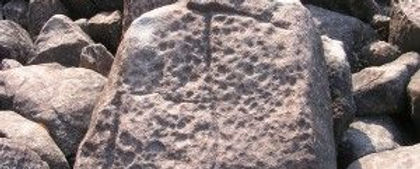
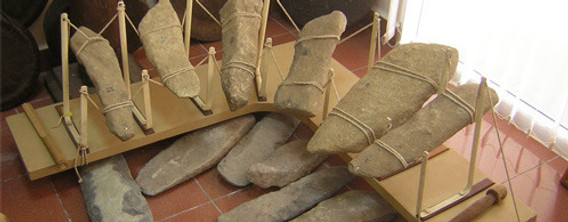

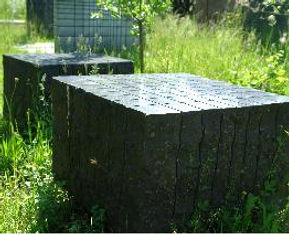
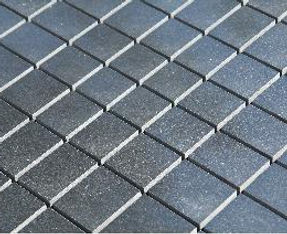

A brief history about Stone and Sound: Video Source: www.youtube.com/user/stoneandsound
Interview with Hannes Fessmann - 27/10/2017 : Video By Steven Halliday

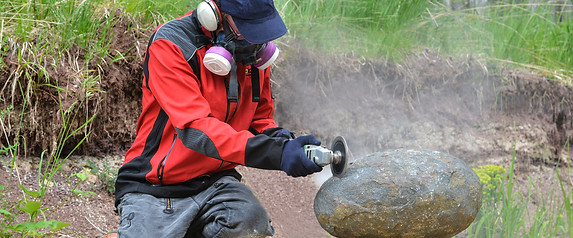
From Caveman to Fessmann.
Introduction:
Some of the oldest stories of mankind are painted and written on stone, be it the prehistoric rock art of the indigenous people of Australia, Africa, and the Americas
or the numerous engravings on the ancient tablets of Egypt and Mesopotamia, stone
has always carried the history of the human race.
Sego Canyon, Utah: Image Source: Al Hartmann
The History of Stone Instruments:
"Stone has been used to make music for thousands of years. Some of the earliest
playings of music involved the striking of rocks. Ringing rocks have been discovered
on various sites across the world, often in close proximity to rock paintings". Rebecca Hildyard. (2010). Ruskin Rocks. Retrieved 15 August, 2017, from https://www.leeds.ac.uk/ruskinrocks/
history%20of%20musial%20stones.htm
Ringing Rocks, Bucks County, Pennsylvania: Image Source: www.misfitsandheroes.wordpress.com
The earliest forms of tuned percussion are to be found in South East Asia, Vietnam, and China. One of the oldest surviving lithophones was discovered in Vietnam in 1949 by Georges Condominas (1921-2011) and is said to be over four thousand years old.
Vietnamese lithophone found by Georges Condominas; Image Source: Mike Adcock
"Remains of other ancient stone instruments come from Chinese archaeological digs, notably from the tomb of Zenghouyi which contained several well-preserved examples. Stone chimes are mentioned in sources as early as the Zhou dynasty (1046–256 BCE) and are commonly found in an obtuse L shape. Sets of 16 stones were also used in Confucian ritual orchestras and survive today in Korean groups called p‟yŏn‟gyŏng". Virginia Gorlinski. (2012). Stone Chimes. Retrieved 15 August, 2017, from https://www.britannica.com/art/stone-chimes
Korean p‟yŏn‟gyŏng: Image Source: Födermayr Collection
The klangsteine story:
In the 1970s German sculptor Elmar Daucher (1932-1989) produced a number of remarkable stone sculptures made from granite, marble, and basalt which produced some interesting sounds. Made originally to be played percussively, the sculptures were created for public spaces and had been originally influenced by the harmonic research of Hans Kayser, who, in 1920's suggested that the principles of harmonious structure in nature were essentially the same as the fundamentals of harmonics.
"One day after a rain shower, Daucher walked through his outdoor studio, wiping the rain off a sculpture discovered that he could make the stone "sing" just by running his hand over it and causing it to vibrate. Hearing this "spherical" sound seemed to touch his basic instincts ". Eric Dorfman Intangible Natural Heritage p102, Routledge, 2012 ISBN 978-0-41-588492-1
Elmar Daucher continued his research into sound and stone throughout the 1980's making a number of pieces. These works proved popular in his native Germany and
were at the center of the exhibitions "Klangskulpturen"85" (Würzburg), "SteinKlangStein" (Ulm 1986) and "Klangsteine - Steinklänge" (Munich 1989).
Elmar Daucher Sound Stone: Image Source: www.symposion-oggelshausen.de
In 1989, German pianist and composer Prof. Klaus Fessmann composed a new musical work based on the book, Höhlensprache "the cave language cycle" by the German
language artist Werner Dürrson.
"For a long time caves exerted great fascination for me. Spatial seclusion, darkness, place of retreat, enclosure, all of these were synonyms for a place that had something to do with me". Klaus Fessmann Retrospektive p12, Emanomedia gmbh, 2015 ISBN 978-3-03-836008-7
Whilst working on this project, Klaus "became familiar with the sculptural stone works of Elmar Daucher, Arthur Schneiter, and others". Irena Nemecek. (2007). Art Productions. Retrieved 20 August 2017, from http://www.art-productions.com/chamber-music/klaus-fessmann-klangsteine/?lang=en
He began to explore the sonic possibilities of stone, researching their various sounds and qualities. In 1992, alongside his eldest son Hannes, he took a trip to the Swiss Alps and began collecting stone for his first prototype instruments. Klaus and Hannes have built over 150 sound stones over the past 27 years and have elevated Elmar Daucher's simplistic, hit and rub sculptures to astonishing new levels of beauty, craftsmanship and sonic capability. The Fessmann sound stones are not just beautifully sculpted objects, they are also fully formed musical instruments.
Prof Klaus Fessmann in his studio at the Universität Mozarteum Salzburg: image Source: http://www.klaus-fessmann.de/
"In 1997, Klaus founded the Ensemble KLANGSTEIN with Manfred Kniel and Friedemann Dähn, the group consists of eight sound stones, an e-cello and some specially developed percussion made of water and stone, the ensemble has performed concerts all over the world". Irena Nemecek. (2007). Art Productions. Retrieved 20 August 2017, from http://www.art productions.com/chamber-music/klaus-fessmann-klangsteine/?lang=en
Klaus Fessmann's most recent stone music project is the Ensemble Laetare, focusing on Andrea Fessmann Letzing contralto voice, the Celtic harp of Georg Baum and his sound stones.
Hannes Fessmann's main focus continues to be on the research, design, and creation of
the stones. He continues to develop the process and regularly holds workshops, performances, and exhibitions. He is currently collaborating with a number of artists,
composers and writers and has recently exhibited his work at the Yorkshire Sculpture Park, Wakefield, UK.
Hannes Fessmann working stone: 2017: Image Source: Wolfgang Steche
Alongside the musical qualities of the sound stones, research has been conducted into their therapeutic effects. Since spring 2009, interested individuals have been trained in sound stone therapy at the Aerpah Clinic in Esslingen-Kennenburg under the supervision of Dr. Martin Runge and Prof Klaus Fessmann. This areas of research includes Alzheimer
memory treatment , micro circulation, increased white blood cells, muscle relaxation,
depression, mindfulness.